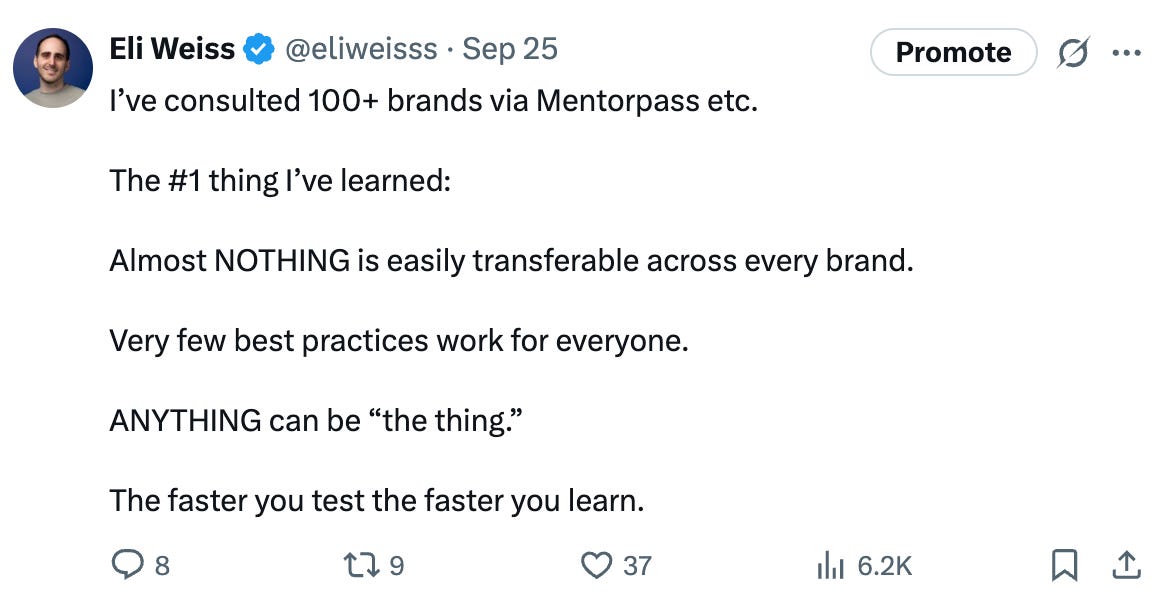3 Things You can Learn from THE BEST BRANDS
here is why everything you try fails (sorry)
Hi team,
A founder I spoke with last week said something I’ve heard 100 times before, just phrased better:
“We tried what everyone said worked, and it completely flopped.”
That convo reminded me of a lesson I keep relearning. I tweeted it out right after:
After consulting with over 100 brands, here’s what I’ve seen over and over:
Almost nothing works the same across every brand.
Very few best practices apply universally.
And almost anything can become “the thing” if the timing, audience, and channel align.
Today, I’m sharing a few things that absolutely can transfer from brand to brand, and a few that way too many people try to copy… that usually fall flat.
Let’s jump in!
This week brought to you by Hire Horatio.
If you’re still telling yourself “we’ll figure out BFCM later,” here’s your wake-up call: later is already too late.
Horatio just launched their new BFCM campaign, and it’s worth a look. The whole concept is a split screen: one side shows the chaos of brands trying to survive the holiday rush without Horatio, the other shows the calm of CX leaders who planned ahead with Horatio’s teams. (Guess which side you want to be on.)
👉 Watch the short animated video here → BFCM Campaign
Stick around ‘til the end — there’s a launch credit waiting for you:
Teams of 5–9 → $2,500 off
Teams of 10+ → $5,000 off
Horatio isn’t just another outsourcer. They’re the boutique CX partner trusted by fast-growing e-comm brands to keep support steady when the volume spikes. With Horatio, BFCM doesn’t have to mean burnout — it can mean smooth scaling, happy customers, and margins intact.
Prep now. Or brace for chaos. Your choice.
Free Mentorship (Holiday Edition)
BFCM is tough — whether it’s your first rodeo or your tenth, the season always finds new ways to test you. The truth? It’s a lot easier when you’ve got someone in your corner who’s been there before.
That’s where Mentors CX comes in: a curated platform connecting CX leaders and founders with world-class mentors. From prepping for BFCM ticket spikes to keeping customers happy through the holidays, Mentors CX gives you access to 1:1 calls, strategic guidance, and a community that gets it.
Thanks to Horatio, I’m giving away 10 free Eclipse memberships (first come, first served) — unlocking full access to the mentor network. Use code ELI-BFCM to claim yours.
Already been through the fire and want to help others survive it? Mentors CX is always welcoming new mentors.
What doesn’t transfer well
1. Plain-text emails, the miracle cure that wasn’t
For a while, everyone on Twitter was yelling that designed emails were dead. Suddenly, every brand was sending plain-text notes “from the founder.” Some crushed. Great opens, solid click-throughs, tons of replies. Agencies couldn’t shut up about it.
So I suggested it to a brand a few months back. We had the right segment. The tone was solid. The copy was tight.
It completely flopped.
Almost no one opened it. No one clicked or replied. Not because it was bad, but because every brand has a different style and customer relationship.
Plain-text isn’t magic. It only works when the customer wants to hear from you like that. Otherwise, it’s just awkward.
2. Cross-selling like your job depends on it
There’s a version of ecommerce where every customer gets hit with three cross-sells in the first week, and the team high-fives because AOV is up 12 percent.
In reality, I’ve watched this kill deliverability, drive up unsubscribes, and burn trust. Brands blast out “next best purchase” campaigns without understanding what that even means for their customer. Or worse, they push bundles that make no sense just to squeeze a few extra bucks.
If someone buys a shampoo, you don’t need to shove a five-piece skincare set at them two days later. Maybe, just maybe, they just wanted the shampoo.
You have to start with consumption behavior. What do people usually come back for? What’s the most common second product? What actually fits?
The best cross-sells feel like helpful nudges. The bad ones feel like someone rooting around in your cart before you’ve even checked out.
3. Urgency tactics with no urgency
Urgency can work. But only when it’s real.
I’ve seen brands with zero inventory issues throw up “almost gone” banners. I’ve seen evergreen products with fake countdown timers. And I’ve seen customers tune it all out after the second send.
You can’t just borrow urgency from someone else’s playbook. If it’s not true, it doesn’t land. And if your product doesn’t need urgency to sell, forcing it feels weird.
You’re not Kith or Supreme. I hope that’s okay.
4. The shipping threshold everyone thinks they need
The standard advice is to set your free shipping threshold just above your average order value. Some brands see a nice lift. Some don’t.
I’ve seen brands push customers to hit the threshold by tossing in low-margin items they didn’t actually want. I’ve also seen flat-rate shipping outperform free shipping in both margin and satisfaction. And subscription-only free shipping is wildly underrated.
This is one of those levers that sounds simple but behaves differently for every business. You won’t know if it works until you run the test, and even then, you need to look past short-term AOV and see what happens to repeat rate and returns.
What does transfer well
1. Talking to your damn customers
If there’s one tactic I’d bet on every time, it’s this. Most people won’t do it because it sounds boring and slow. It’s not. It’s the only shortcut that actually works.
You can learn more from ten good customer interviews than from a month of A/B testing. You get to see how people describe your product in their own words, what they expected when they bought, what they thought they were solving, what almost stopped them, and what got them to come back.
If you don’t know where to start, this cheat sheet from the folks at LearnWhyWeBuy is a gift: learnwhywebuy.com/clarity-calls-cheatsheets
Use it. Book the calls. Ask normal human questions. Don’t pitch. Don’t correct them. Just listen. The more you shut up, the more useful it gets.
Best case, you find the raw material for your next 10 flows, landing page headlines, ad hooks, and bundling strategy. Worst case, you sound like someone who actually gives a sh!t.
2. Prioritizing tests by impact and lift
Most brands say they “test everything.” Most of those tests happen because someone had a spicy idea and a free hour.
There’s a better way to do this. Make a two-by-two. Map every idea by expected impact and level of effort. You don’t even need a whiteboard. A Google Sheet works fine.
Start with high-impact, low-lift. That’s where the money is.
If you want to test bundling, you don’t need to rebuild your PDP. Start with a mini-bundle in the slide cart. Or add it to the post-purchase screen. Get the signal before you rebuild the store.
Same with offer testing. Try a discount in the cart, versus the checkout, versus post-purchase. Try $10 off instead of 15 percent. Try free shipping only on subscriptions. Try anything, really, as long as you keep it scrappy, measurable, and tied to an actual hypothesis.
You don’t need to be scientific. You just need to not waste time.
3. Working backward from your best customers
If you want more high-LTV customers, start by studying the ones you already have.
Find the people who ordered five or ten times. What did they buy first? How long did it take them to come back? Did they stick to one category or bounce around?
You’re not trying to reverse-engineer their exact journey. You’re trying to find the patterns. If the customers who bought Product A first are 3x more likely to still be around six months later, you want more people starting with Product A.
Once you know what your best customers do, you can build around that. Change the welcome flow. Adjust the landing pages. Push different first-time offers. Add a card in the box that nudges toward the second product.
You don’t need to force it. You just need to give people a gentle shove in the right direction.
That’s it for this week!
Any topics you’d like to see me cover in the future?
Just shoot me a DM or an email!
P.S. If you want to figure out how to get your brand to rank high in LLMs and show up in ChatGPT, Gemini, and more… check this out.








